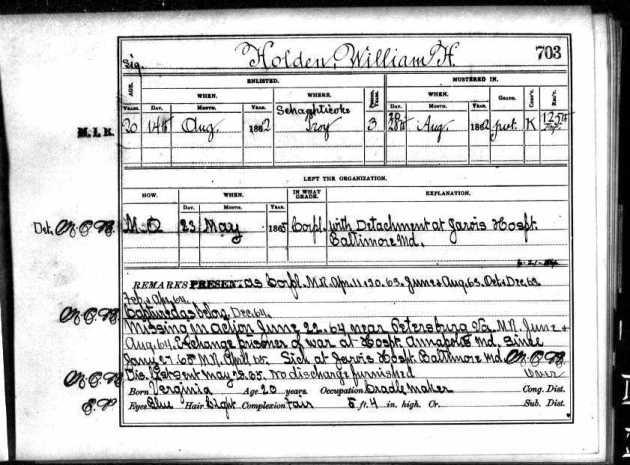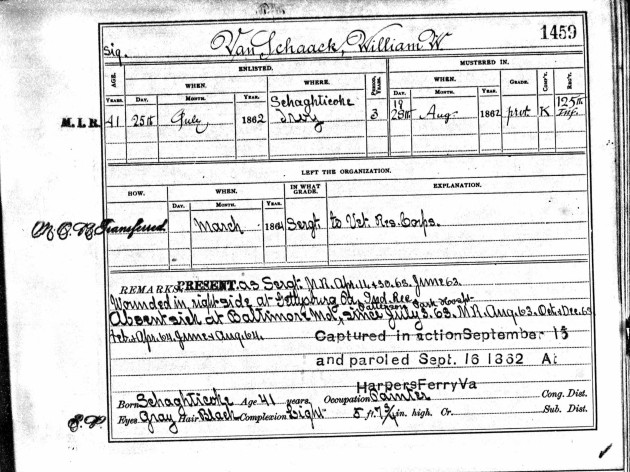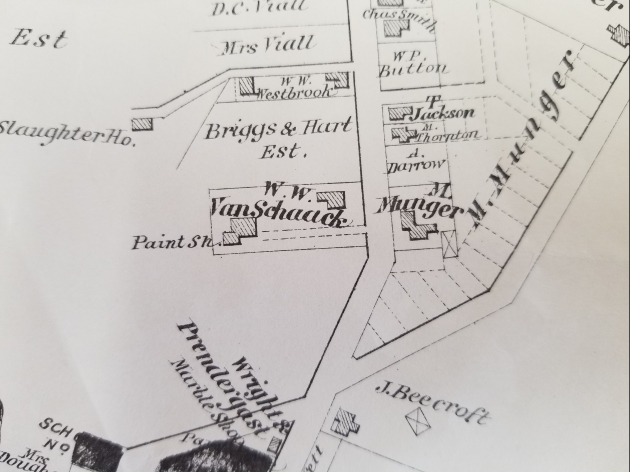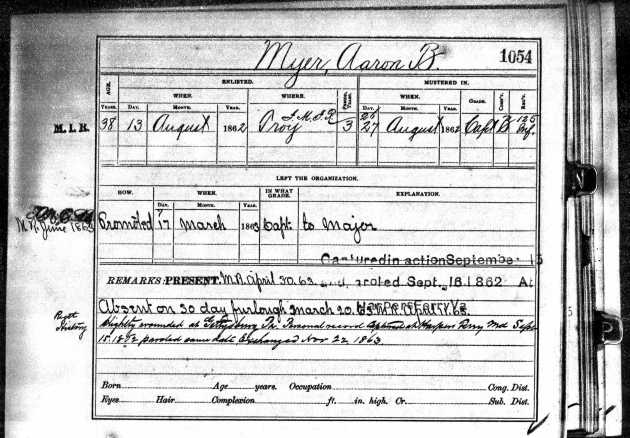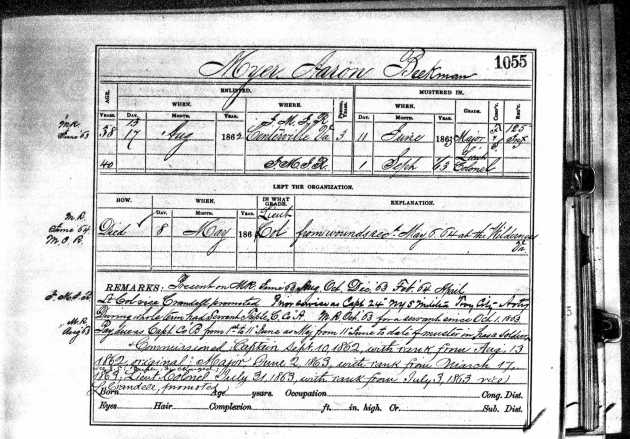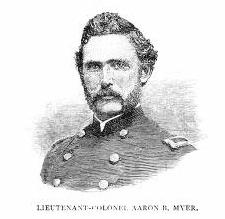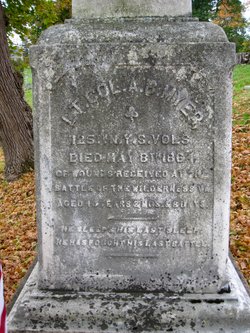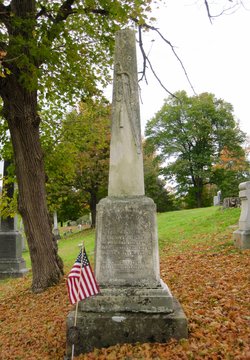To me, the story of Job A. Grant is one of the saddest of many sad Civil War stories. Job enlisted as a Private in Company K of the 125th with everyone else in August of 1862. He was born in Schaghticoke, with blue eyes, light hair and a fair complexion, 5’8” tall. He gave his occupation as mechanic, and his age as 21- though I think he was 19. By April of 1863 he had been promoted to Sergeant.
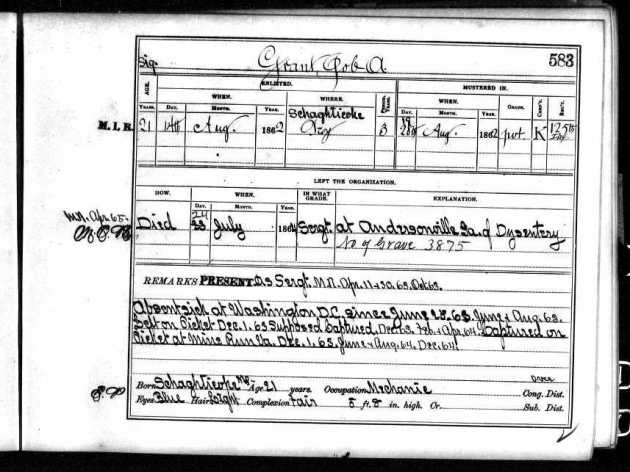
The N.Y.S. Muster Card of Job A. Grant
Job’s father, John, was the brother of Isaac Grant, inventor, and proprietor of the factory which made grain cradles and fanning mills in what is now Grant’s Hollow. Isaac was about ten years older than John, and always employed him in the business. In the 1850 US Census, John was a mechanic, implying he worked making the machinery, while Isaac was a manufacturer. In the 1855 NY Census, the brothers lived next door, though Isaac owned a large house and John rented a small one. At that point John was 38, his wife Catherine 35, and they had four children. Job, the eldest, was 12. In the 1860 US Census, John was called a machinist. The family consisted of Job, 17, Mary, 15, Warren, 12, Nora, 10, Inez, 5, and Stella, 3. While the family was not wealthy: John owned no real estate and had a personal estate of just $300, brother Isaac certainly employed both John and then Job- as indicated by the occupation he gave when he enlisted.
John Grant and his wife were killed in a railroad accident on the Troy and Boston Railroad near Buskirk’s Bridge (Troy “Daily Times” January 16, 1862). They were on the way to the funeral of a friend in their carriage when a train struck their wagon, “sending its occupants high in the air, demolishing the vehicle into fragments….their sad untimely fate is regretted by all….Mr Grant was employed as superintendent of the large manufacturing establishment of his brother.” Who knows why the Grants didn’t see- or hear- the train coming? It was winter- maybe snowbanks? But they were in a carriage and not a sleigh, which implies pretty clear roads. They were able to travel in a vehicle with wheels, rather than one with runners.
I don’t understand why Job, eldest child in a large family, would go ahead and enlist in the Army in the summer after his parents had died, leaving him in charge of his young sisters. He had a job, and he must have been a responsible young man, as he was quickly promoted to Sergeant in the Army. Another of Isaac Grant’s employees, William Holden, enlisted at the same time, so perhaps he was caught up in the patriotic fervor. His cousin, Job P. Grant, son of Isaac, registered for the draft as required, but did not enlist. He was a bit older (26 in 1862) and married, so perhaps that dissuaded him.
Not long after Job A. was promoted to Sergeant in the spring of 1863 he was absent ill for a while in the hospital in Washington, DC. He returned to duty and was out on picket duty near Mine Run, Virginia on December 1, 1863, when he was captured by the Confederates along with forty other men. He was the only Sergeant in the captive group.
According to the Regimental History, General Meade and the Union army were arrayed facing General Lee and the Confederates across the stream Mine Run, ready for battle. The night of December 1, Meade decided to withdraw his Army rather than attack the enemy under very adverse conditions. Due to an error of command, the 41 men on picket duty from the 125th were not withdrawn with the rest of the regiment and the rest of the army and were captured. This constituted 1/7th of the Regiment at the time. The men were prisoners at Belle Island, near Richmond, for two months, then at Richmond for two weeks, then were transferred to Andersonville, Georgia when it opened in February 1864. Only nine survived. Job died of dysentery on July 23, 1864. Hopefully he and the other men of Company K of the 125th who were there: W.O. Carr, Douglas Fisher, C.E. Stratton, John Conlin, Fred Scharp, Alexander Whyland, James K. Simon, Arteus Loomis, and Andrew Jackson Doty stuck together and supported each other. Stratton and Fisher died in June, Carr in August, and Conlon in September. Simon, plus Loomis and Doty, who arrived at Andersonville after the others, were transferred to Florence, South Carolina when Andersonville closed in September, as the Union army closed in, and survived the war.

Tombstone of Job A. Grant at Andersonville National Cemetery, Georgia

Vista of graves at Andersonville National Cemetery. Prisoners were buried in trenches, shoulder to shoulder. At the time Job Grant died, at least 100 men were dying each day.

Obverse of the N.Y.S. monument at Andersonville National Cemetery. More N.Y. soldiers died there than from any other state.
The 1865 NY Census reported Job’s death, listing him as the guardian of four dependent sisters. Brother Warren, only 17 by this point, must have been out on his own. I found Warren as a 22-year-old farm laborer in Canaan, Columbia County in 1870. He married and stayed there- even had a daughter named Inez like his sister- and died in 1914. In the 1865 NY Census, baby Stella was living with her uncle and aunt, Henry and Eliza Rose in Schaghticoke. In 1880, she married a man named Charles Washington Williams, a dry goods merchant in Manhattan, and lived the rest of her life there, dying in 1898. Two of her sisters were also in Manhattan. Mary married a lawyer, John Vincent, who became a District Attorney. Nora married William Connel, also a merchant. Inez married Charles Jackson, who worked for Singer Sewing Machine Company, in 1882, and died just a year later. The children did not apply for military benefits based on their brother’s service, but perhaps they didn’t need them.
